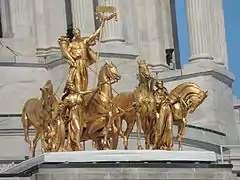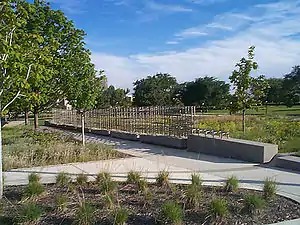Minnesota State Capitol Mall
The Minnesota State Capitol Mall includes eighteen acres of green space. Over the years, monuments, and memorials, have been added to the mall.[1] The mall has been called Minnesota's Front lawn and is a place where the public has gathered for celebrations, to party, to demonstrate and protest, and to grieve.

1. Leif Erikson
2. Quadriga: Progress of the State
3. Judicial Plaza
4. Floyd B. Olson – Governor during depression years
5. John Johnson – 1st Governor born in state
6. Knute Nelson: 1st foreign born Governor
7. Hubert H. Humphrey
8. The Women’s Suffrage Memorial Garden
9. Charles Lindbergh: The Boy and the Man
10. Roy Wilkins Memorial
11. Laos Special Forces Memorial
12. MN Vietnam Memorial
13. Court of Honor
14. Korean War Veterans Memorial
15. MN Workers Memorial
16. Military Family Tribute
17. MN World War II Veterans Memorial
18. Fallen Firefighters Memorial
19. Monument to the Living
20. Promise of Youth
21. U.S.S. Ward Gun
22. The Peace Officers Memorial
23. Earthbound
24. Liberty Bell
A. Christopher Columbus Memorial (pedestal)
The mall is overseen by the Capitol Area Architectural and Planning Board (CAAPB), a small state agency consisting of twelve members, with responsibilities to preserve and enhance the dignity, beauty, and architectural integrity of the capitol, the buildings adjacent to it, the capitol grounds, and the capitol area.[2]
History

On March 15, 1894, the board engaged the St. Paul civil engineering and surveying firm of Fowble and Fitz to prepare a report with diagrams of the site of the third Minnesota State Capitol. The site was bounded by University Avenue on the north, Park to Wabasha Street to Central Avenue on the west and southwest, Central Avenue to Cedar Street on the southeast, and Cedar Street on the east to University Avenue.
In the beginning for the planning of the third State Capitol, a Capitol approach with surrounding grounds received little attention. The Board of State Capitol Commissioners, essentially prohibited development plans of the grounds in the 1895 architectural competition instructions.[3]
When the Minnesota State Capitol opened in 1905, instead of the vast open green space of the State Capitol Mall, lined with state office buildings, it overlooked shaped small patch of green space and an asymmetric jumble of streets lined with commercial and residential structures built between the 1870s and early 1900s.[4]

The architect of the Minnesota State Capitol Cass Gilbert continued to advocate for a grand capitol approach that would do justice to his building’s design until the end of his life, 30 years later.[5]
Gilbert’s capitol approach plan followed the Beaux-Arts precedents of the 1893 Chicago World’s Columbian Exposition "White City" and the McMillan Plan for a park system in Washington, DC.
However, Minnesota legislators had little appetite in authorizing and appropriating the funds for the acquisition of nearby properties to implement Gilbert's grand vision.
Gilbert’s ideas were incorporated into two larger city plans for St. Paul, proposed in 1911 and in 1922. Both were promoted in part by local business interests, but neither plan was formally adopted.[6]
As time went on, the aging neighborhood surrounding the State Capitol, the blocks to the south, east, and west became increasingly deteriorated. In 1936 an article in Fortune magazine, accompanied by a watercolor illustration that depicted the capitol rising above the local slums, called "among the worst in the land."[7]
A variety of grand proposals for more suitable frontage for the State Capitol were presented throughout the years but it wasn’t until the end of World War II that city and state interests would finally align and a plan would take shape for the State Capitol Mall.
Designed by the landscape architecture firm of Morell and Nichols, the plan partially realized Gilbert’s vision of landscaped grand boulevards providing key approaches to the capitol but removed Gilbert's Capitol south approach from Seven Corners. Not having it in the plan would be easier for the legislature to approve because it required less property acquisition. Instead the plan included an axial pedestrian mall leading from the capitol steps and terminating at a “court of honor," north of the Veterans Service Building site.[5]
Funded by a $2 million state appropriation, the mall was planned to provide a grand setting for the State Capitol and for several new state buildings to be constructed in the future. The plan also anticipated a new “national defense” highway (today’s Interstate 94), then in the planning stages, extending through downtown St. Paul requiring the destruction of numerous structures for its right of way.[5]
Following approval of the plan, both the state commission and the City of St. Paul began to acquire property. More than 100 homes and buildings, including two churches, several apartment buildings, and “many sub-standard private homes” were condemned and then demolished to make room for the Capitol Mall and land for state buildings. Within five years, the neighborhood south of the Capitol was completely gone. [4][5]
The work was largely complete by 1955, leaving the State Capitol Mall with the overall form that still provides the setting for the Minnesota State Capitol.
Monuments
A list of monuments and memorials on and around the State Capitol Mall.
Please note this is about the text of this Wikipedia article; it should not be taken to reflect on the subject of this article.
Do not restore or edit the blanked content on this page until the issue is resolved by an administrator, copyright clerk or OTRS agent.
If you have just labeled this page as a potential copyright issue, please follow the instructions for filing at the bottom of the box.

The previous content of this page or section has been identified as posing a potential copyright issue, as a copy or modification of the text from the source(s) below, and is now listed at Copyright problems :
Temporarily, the original posting is still accessible for viewing in the page history.
- You must permit the use of your material under the terms of the Creative Commons Attribution-Sharealike 3.0 Unported License (CC BY-SA 3.0) and the GNU Free Documentation License (GFDL) (unversioned, with no invariant sections, front-cover texts, or back-cover texts).
- Explain your intent to license the content on this article's discussion page.
- To confirm your permission, you can either display a notice to this effect at the site of original publication or send an e-mail from an address associated with the original publication to permissions-en
 wikimedia.org or a postal letter to the Wikimedia Foundation. These messages must explicitly permit use under CC BY-SA and the GFDL. See Wikipedia:Donating copyrighted materials.
wikimedia.org or a postal letter to the Wikimedia Foundation. These messages must explicitly permit use under CC BY-SA and the GFDL. See Wikipedia:Donating copyrighted materials. - Note that articles on Wikipedia must be written from a neutral point of view and must be verifiable in published third-party sources; consider whether, copyright issues aside, your text is appropriate for inclusion in Wikipedia.
Your rewrite should be placed on this page, where it will be available for an administrator or clerk to review it at the end of the listing period. follow this link to a temporary subpage.
- Simply modifying copyrighted text is not sufficient to avoid copyright infringement—if the original copyright violation cannot be cleanly removed or the article reverted to a prior version, it is best to write the article from scratch. (See Wikipedia:Close paraphrasing.)
- For license compliance, any content used from the original article must be properly attributed; if you use content from the original, please leave a note at the top of your rewrite saying as much. You may duplicate non-infringing text that you had contributed yourself.
- It is always a good idea, if rewriting, to identify the point where the copyrighted content was imported to Wikipedia and to check to make sure that the contributor did not add content imported from other sources. When closing investigations, clerks and administrators may find other copyright problems than the one identified. If this material is in the proposed rewrite and cannot be easily removed, the rewrite may not be usable.
- Posting copyrighted material without the express permission of the copyright holder is considered copyright infringement, which is both illegal and against Wikipedia policy.
- If you have express permission, this must be verified either by explicit release at the source or by e-mail or letter to the Wikimedia Foundation. See Wikipedia:Declaration of consent for all enquiries.
- Policy requires that we block those who repeatedly post copyrighted material without express permission.
If you have tagged the article for investigation, please complete the following steps:
- Add the following to the bottom of Wikipedia:Copyright problems/2021 February 5:
* {{subst:article-cv|Minnesota State Capitol Mall}} from https://mn.gov/caapb/capitol-area/memorials-monuments/. ~~~~ - Place this notice on the talk page of the contributor of the copyrighted material:
{{subst:Nothanks-web|pg=Minnesota State Capitol Mall|url=https://mn.gov/caapb/capitol-area/memorials-monuments/}} ~~~~ - To hide a section instead of an entire article, add the template to the beginning of the section and {{Copyvio/bottom}} at the end of the portion you intend to blank.




















